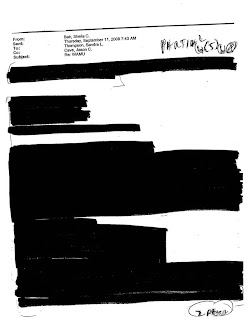by Calculated Risk on 12/13/2009 09:27:00 AM
Sunday, December 13, 2009
WaMu Freedom of Information Request Denied
 Click on graph for larger image in new window.
Click on graph for larger image in new window.
Kirsten Grind provides some of the responses to the Puget Sound Business Journal's requests for information: The fight for WaMu documents (ht Spatch)
The Puget Sound Business Journal for months has asked the Office of Thrift Supervision (OTS), the federal agency that regulated Washington Mutual, to release internal communications between WaMu's regulators.In her article last week, Kirsten asks: Why Did They Close WaMu?. From the piece:
The newspaper made its requests under the U.S. Freedom of Information Act, the decades-old law that requires federal agencies to disclose public documents.
Of particular interest were internal emails, which could help explain why regulators seized the bank in September 2008 even though WaMu appeared to meet regulatory standards for operating banks, despite its burden of bad loans. (You can read the second installment of our six-month investigation about that decision here. The first in the series, about the bank's final days is here.)
On Wednesday, an OTS official told the Business Journal in an email: “After careful review, I have determined that your request, as it pertains to the above-referenced documents, is denied in full.”
[D]ocuments and interviews with former WaMu employees show that regulators closed WaMu even though it had liquidity and capital that were well above the levels at which a bank might normally be threatened with closure.It appears that WaMu employees considered the untapped FHLB and Fed lines of credit of over $14 billion as part of WaMu's $29 billion in net liquidity - and unmentioned (but likely) is that the Seattle FHLB and the Fed were probably about ready to pull those lines - and the FDIC probably knew that was about to happen and closed WaMu. Of course we don't know from the FOIA documents!
Typically, a bank is in danger of being seized if its net liquidity dips below 5 percent of total assets, according to banking experts and former regulators. On the day regulators shut WaMu, the bank had $29 billion in net liquidity—about 9.4 percent of assets, and nearly twice the closure threshold. The figure was provided by a former senior WaMu manager who closely tracked the bank’s liquidity at the time. It was confirmed by a former top WaMu executive who had full knowledge of the bank’s liquidity position.
“With the cash it had, WaMu should never have been seized,” said a senior banking regulator familiar with the matter.
...
Other documents also support the view that WaMu had sufficient liquidity to stay open. The last liquidity report from inside WaMu shows that on September 11 the bank could borrow $6.2 billion from the Federal Home Loan Banks in Seattle and San Francisco. It could borrow an additional $8.2 billion from the Federal Reserve Bank, a line that it hadn’t accessed at the time of its seizure, according to two people familiar with the matter.
But this would be just like a homeowner with an unused HELOC. Just when the homeowner is about to use the HELOC, the bank reduces or eliminates the line, and the homeowner's "liquidity" vanishes. Funny thing about liquidity - it can be there one day, and gone the next.


